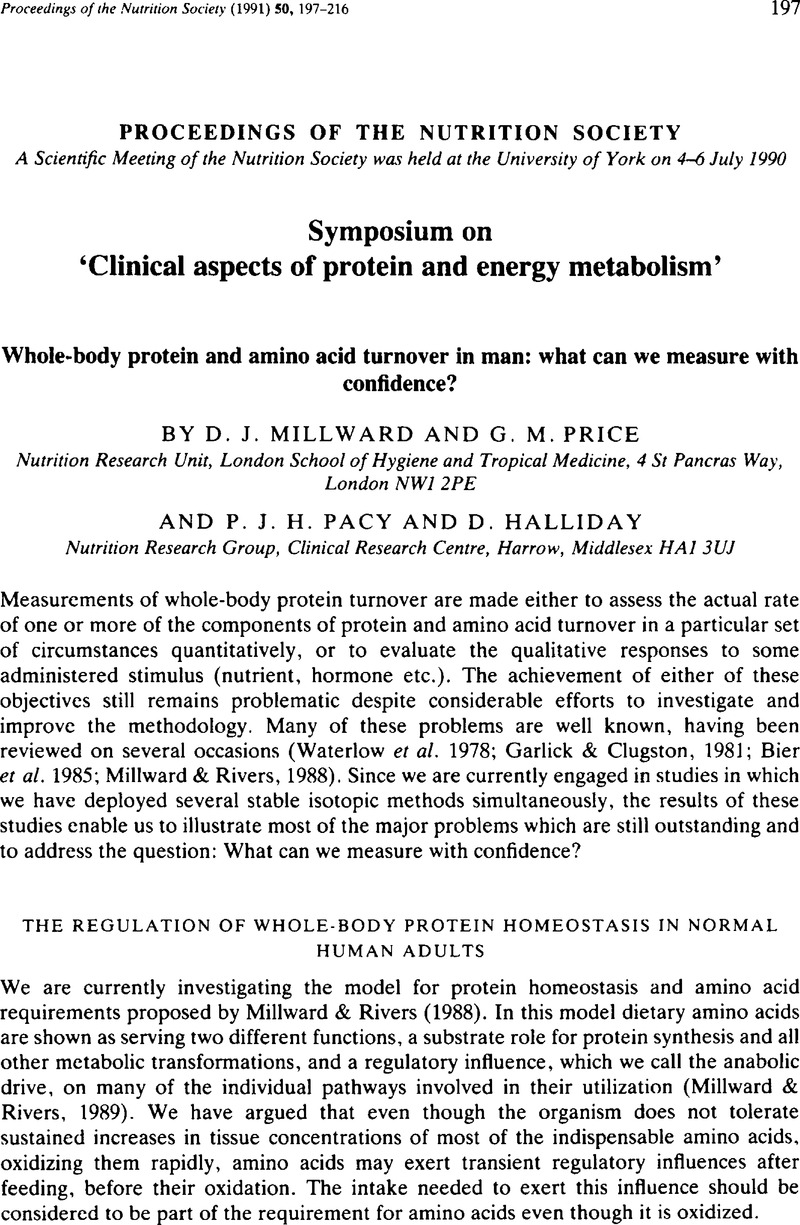Crossref Citations
This article has been cited by the following publications. This list is generated based on data provided by Crossref.
YOUNG, VERNON R.
YU, YONG‐MING
and
FUKAGAWA, NAOMI K.
1991.
Protein and Energy Interactions Throughout Life1.
Acta Paediatrica,
Vol. 80,
Issue. s373,
p.
5.
Cortiella, J
Marchini, JS
Branch, S
Chapman, TE
and
Young, VR
1992.
Phenylalanine and tyrosine kinetics in relation to altered protein and phenylalanine and tyrosine intakes in healthy young men.
The American Journal of Clinical Nutrition,
Vol. 56,
Issue. 3,
p.
517.
Jackson, A. A.
and
Margetts, B. M.
1993.
Protein intakes in the adult population of the UK.
International Journal of Food Sciences and Nutrition,
Vol. 44,
Issue. 2,
p.
95.
Weijs, P. J. M.
Schreurs, V. V. A. M.
Koopmanschap, R. E.
Grooten, H. N. A.
Schoonman, A. T.
and
Boekholt, H. A.
1993.
Effects of acute and chronic level of protein supply on metabolic leucine utilization in growing and mature rats.
British Journal of Nutrition,
Vol. 70,
Issue. 1,
p.
117.
Millward, J
1993.
Stable-isotope-tracer studies of amino acid balance and human indispensable amino acid requirements.
The American Journal of Clinical Nutrition,
Vol. 57,
Issue. 1,
p.
81.
Pisters, Peter W. T.
Pearlstone, David B.
and
Toroslan, M. H.
1993.
Protein and Amino Acid Metabolism in Cancer Cachexia: Investigative Techniques and Therapeutic Interventions.
Critical Reviews in Clinical Laboratory Sciences,
Vol. 30,
Issue. 3,
p.
223.
Marchini, JS
Cortiella, J
Hiramatsu, T
Chapman, TE
and
Young, VR
1993.
Requirements for indispensable amino acids in adult humans: longer-term amino acid kinetic study with support for the adequacy of the Massachusetts Institute of Technology amino acid requirement pattern.
The American Journal of Clinical Nutrition,
Vol. 58,
Issue. 5,
p.
670.
Fairweather‐Tait, Susan J.
1993.
Optimal nutrient requirements: important concepts.
Journal of Human Nutrition and Dietetics,
Vol. 6,
Issue. 5,
p.
411.
Jackson, A. A.
1993.
Chronic malnutrition: protein metabolism.
Proceedings of the Nutrition Society,
Vol. 52,
Issue. 1,
p.
1.
Motil, Kathleen J
Opekun, Antone R
Montandon, Corinne M
Berthold, Heiner K
Davis, Teresa A
Klein, Peter D
and
Reeds, Peter J
1994.
Leucine Oxidation Changes Rapidly after Dietary Protein Intake is Altered in Adult Women but Lysine Flux Is Unchanged As Is Lysine Incorporation into VLDL-Apolipoprotein B-100.
The Journal of Nutrition,
Vol. 124,
Issue. 1,
p.
41.
Hiramatsu, T
Cortiella, J
Marchini, JS
Chapman, TE
and
Young, VR
1994.
Plasma proline and leucine kinetics: response to 4 wk with proline-free diets in young adults.
The American Journal of Clinical Nutrition,
Vol. 60,
Issue. 2,
p.
207.
Young, Vernon R
and
El-Khoury, Antoine E
1994.
Reply to AA Jackson.
The American Journal of Clinical Nutrition,
Vol. 60,
Issue. 6,
p.
978.
Marchini, JS
Cortiella, J
Hiramatsu, T
Castillo, L
Chapman, TE
and
Young, VR
1994.
Phenylalanine and tyrosine kinetics for different patterns and indispensable amino acid intakes in adult humans.
The American Journal of Clinical Nutrition,
Vol. 60,
Issue. 1,
p.
79.
Millward, Joe
1994.
Can We Define Indispensable Amino Acid Requirements and Assess Protein Quality in Adults?.
The Journal of Nutrition,
Vol. 124,
Issue. ,
p.
1509S.
Sánchez, M
el-Khoury, AE
Castillo, L
Chapman, TE
and
Young, VR
1995.
Phenylalanine and tyrosine kinetics in young men throughout a continuous 24-h period, at a low phenylalanine intake.
The American Journal of Clinical Nutrition,
Vol. 61,
Issue. 3,
p.
555.
Yu, YM
Ryan, CM
Burke, JF
Tompkins, RG
and
Young, VR
1995.
Relations among arginine, citrulline, ornithine, and leucine kinetics in adult burn patients.
The American Journal of Clinical Nutrition,
Vol. 62,
Issue. 5,
p.
960.
Grove, G.
and
Jackson, A. A.
1995.
Measurement of protein turnover in normal man using the end-product method with oral [15N]glycine: comparison of single-dose and intermittent-dose regimens.
British Journal of Nutrition,
Vol. 74,
Issue. 4,
p.
491.
Berthold, Heiner K.
Jahoor, Farook
Klein, Peter D.
and
Reeds, Peter J.
1995.
Estimates of the Effect of Feeding on Whole-Body Protein Degradation in Women Vary with the Amino Acid Used as Tracer.
The Journal of Nutrition,
Vol. 125,
Issue. 10,
p.
2516.
Yu, Yong‐Ming
Young, Vernon R.
Tompkins, Ronald G.
and
Burke, John F.
1995.
Comparative Evaluation of the Quantitative Utilization of Parenterally and Enterally Administered Leucine and L‐[1–13C,15N]Leucine Within the Whole Body and the Splanchnic Region.
Journal of Parenteral and Enteral Nutrition,
Vol. 19,
Issue. 3,
p.
209.
Weijs, P. J. M.
Schreurs, V. V. A. M.
and
Maas, M. I. M.
1995.
Meal frequency and diurnal leucine oxidation in mature rats.
Journal of Animal Physiology and Animal Nutrition,
Vol. 74,
Issue. 1-5,
p.
131.



